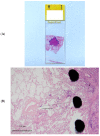Evaluation of Microscopic Tumour Extension in Localized Stage Non-Small-Cell Lung Cancer for Stereotactic Radiotherapy Planning
- PMID: 35267589
- PMCID: PMC8909894
- DOI: 10.3390/cancers14051282
Evaluation of Microscopic Tumour Extension in Localized Stage Non-Small-Cell Lung Cancer for Stereotactic Radiotherapy Planning
Abstract
Background: Stereotactic radiotherapy for localised stage non-small-cell lung carcinoma (NSCLC) is an alternative indication for patients who are inoperable or refuse surgery. A study showed that the microscopic tumour extension (ME) of NSCLC varied according to the histological type, which allowed us to deduce adapted margins for the clinical target volume (CTV). However, to date, no study has been able to define the most relevant margins for patients with stage 1 tumours. Methods: We performed a retrospective analysis including patients with adenocarcinoma (ADC) or squamous cell carcinoma (SCC) of localised stage T1N0 or T2aN0 who underwent surgery. The ME was measured from this boundary. The profile of the type of tumour spread was also evaluated. Results: The margin required to cover the ME of a localised NSCLC with a 95% probability is 4.4 mm and 2.9 mm for SCC and ADC, respectively. A significant difference in the maximum distance of the ME between the tumour-infiltrating lymphocytes (TILs), 0−10% and 50−90% (p < 0.05), was noted for SCC. There was a significant difference in the maximum ME distance based on whether the patient had chronic obstructive pulmonary disease (COPD) (p = 0.011) for ADC. Multivariate analysis showed a statistically significant relationship between the maximum microextension distance and size with the shrinkage coefficient. Conclusion: This study definitively demonstrated that the ME depends on the pathology subtype of NSCLC. According to International Commission on Radiation Units and Measurements (ICRU) reports, 50, 62 and 83 CTV margins, proposed by these results, should be added to the GTV (Gross tumour volume). When stereotactic body radiation therapy is used, this approach should be considered in conjunction with the dataset and other margins to be applied.
Keywords: adenocarcinoma; non-small-cell lung carcinoma; squamous cell carcinoma; stereotactic body radiation therapy.
Conflict of interest statement
The authors declare no conflict of interest.
Figures





Similar articles
-
Evaluation of microscopic tumor extension in non-small-cell lung cancer for three-dimensional conformal radiotherapy planning.Int J Radiat Oncol Biol Phys. 2000 Nov 1;48(4):1015-24. doi: 10.1016/s0360-3016(00)00750-1. Int J Radiat Oncol Biol Phys. 2000. PMID: 11072158
-
[A comparative study on radiology and pathology target volume in non-small-cell lung cancer].Zhonghua Zhong Liu Za Zhi. 2003 Nov;25(6):566-8. Zhonghua Zhong Liu Za Zhi. 2003. PMID: 14690563 Chinese.
-
Clinicopathologic analysis of microscopic extension in lung adenocarcinoma: defining clinical target volume for radiotherapy.Int J Radiat Oncol Biol Phys. 2007 Oct 1;69(2):334-41. doi: 10.1016/j.ijrobp.2007.03.023. Epub 2007 Jun 14. Int J Radiat Oncol Biol Phys. 2007. PMID: 17570609
-
Optimal Clinical Target Volume of Radiotherapy Based on Microscopic Extension around the Primary Gross Tumor in Non-Small-Cell Lung Cancer: A Systematic Review.Cancers (Basel). 2022 May 7;14(9):2318. doi: 10.3390/cancers14092318. Cancers (Basel). 2022. PMID: 35565447 Free PMC article. Review.
-
Is radiofrequency ablation more effective than stereotactic ablative radiotherapy in patients with early stage medically inoperable non-small cell lung cancer?Interact Cardiovasc Thorac Surg. 2012 Aug;15(2):258-65. doi: 10.1093/icvts/ivs179. Epub 2012 May 10. Interact Cardiovasc Thorac Surg. 2012. PMID: 22581864 Free PMC article. Review.
Cited by
-
Computed tomography radiomics of intratumoral and peritumoral microenvironments for identifying the invasiveness of subcentimeter lung adenocarcinomas.BMC Med Imaging. 2025 Aug 18;25(1):331. doi: 10.1186/s12880-025-01882-z. BMC Med Imaging. 2025. PMID: 40826397 Free PMC article.
-
Determining optimal clinical target volume margins based on microscopic extracapsular extension of metastatic nodes in patients with non-small-cell lung cancer after chemotherapy or chemotherapy combined with immunotherapy.BMC Cancer. 2024 Nov 8;24(1):1368. doi: 10.1186/s12885-024-13135-3. BMC Cancer. 2024. PMID: 39516726 Free PMC article.
References
-
- Chang J.Y., Mehran R.J., Feng L., Verma V., Liao Z., Welsh J.W., Lin S.H., O’Reilly M.S., Jeter M.D., Balter P.A., et al. Stereotactic Ablative Radiotherapy for Operable Stage I Non-Small-Cell Lung Cancer (Revised STARS): Long-Term Results of a Single-Arm, Prospective Trial with Prespecified Comparison to Surgery. Lancet Oncol. 2021;22:1448–1457. doi: 10.1016/S1470-2045(21)00401-0. - DOI - PMC - PubMed
-
- Chang J.Y., Senan S., Paul M.A., Mehran R.J., Louie A.V., Balter P., Groen H.J.M., McRae S.E., Widder J., Feng L., et al. Stereotactic Ablative Radiotherapy versus Lobectomy for Operable Stage I Non-Small-Cell Lung Cancer: A Pooled Analysis of Two Randomised Trials. Lancet Oncol. 2015;16:630–637. doi: 10.1016/S1470-2045(15)70168-3. - DOI - PMC - PubMed
LinkOut - more resources
Full Text Sources
Research Materials

